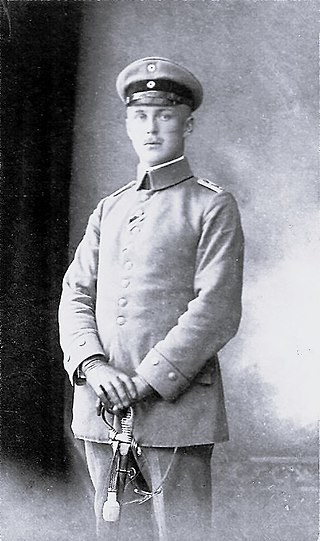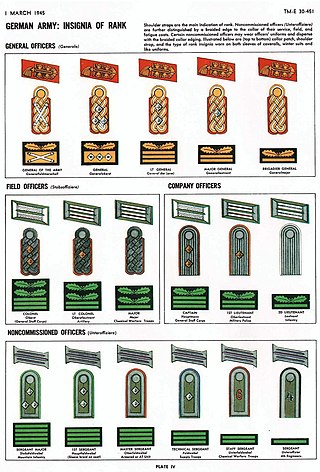Feldwebel is a non-commissioned officer (NCO) rank in several countries. The rank originated in Germany, and is also used in Switzerland, Finland, Sweden, and Estonia. The rank has also been used in Russia, Austria-Hungary, occupied Serbia and Bulgaria.
Oberfeldwebel is the fourth highest non-commissioned officer (NCO) rank in German Army and German Air Force.
Stabsfeldwebel is the second highest Non-commissioned officer (NCO) rank in German Army and German Air Force. It is grouped as OR-8 in NATO, equivalent to a First Sergeant in the United States Army, and to Warrant Officer Class 2 in the British Army. Promotion to the rank requires at least twelve years total active duty, of which at least eleven years have elapsed since promotion to unteroffizier, with at least ten years since promotion to stabsunteroffizier, and nine years since promotion to feldwebel. In army/ air force context NCOs of this rank were formally addressed as Herr Stabsfeldwebel also informally / short Staber.
Unteroffizier is a junior non-commissioned officer rank used by the Bundeswehr. It is also the collective name for all non-commissioned officers in Austria and Germany. It was formerly a rank in the Imperial Russian Army.

SS-Stabsscharführer was not a rank, but a position title or appointment, mainly used in the Waffen-SS, equivalent to the Hauptfeldwebel of the Wehrmacht between the years of 1938 to 1945.
Bootsmann is a naval rank used in some navies.

Unteroffizier(e) mit Portepee, also Portepeeunteroffizier(e) (transl. Non-commissioned officer(s) with sword knot), is the designation for German senior non-commissioned officers in the armed forces of Germany. The title derives from the French porte-épée ("sword bearer"), as senior enlisted men would historically carry a sword into battle.
Fähnrich zur See designates in the German Navy of the Bundeswehr a military person or member of the armed forces with the second highest Officer Aspirant rank. According to the salary class it is equivalent to the Portepeeunteroffizier ranks Bootsmann (Marine) and Feldwebel of Heer or Luftwaffe.
Seekadett is a military rank of the Bundeswehr and of former German-speaking naval forces.

The Heer as the German army and part of the Wehrmacht inherited its uniforms and rank structure from the Reichsheer of the Weimar Republic (1921–1935). There were few alterations and adjustments made as the army grew from a limited peacetime defense force of 100,000 men to a war-fighting force of several million men.
The rank insignia of the federal armed forces of the Federal Republic of Germany indicate rank and branch of service in the German Army, German Air Force, or the German Navy.
Oberstabsfeldwebel is the highest Non-commissioned officer (NCO) rank in German Army and German Air Force. It is grouped as OR9 in NATO, equivalent to a sergeant major in the United States Army and a Warrant Officer Class 1 in the British Army. Attainment of this rank requires at least sixteen years since promotion to feldwebel and at least six years since promotion to hauptfeldwebel

Zugführer is a military appointment to a sub-subunit leader, e.g. platoon leader, belonging to the Non-commissioned officer (NCO) rank group or junior officer. A Zugführer leads or commands normally a subunit that is called in German language Zug.
The ranks of the German Armed Forces,, were set up by the President with the Anordnung des Bundespräsidenten über die Dienstgradbezeichnungen und die Uniform der Soldaten on the basis of section 4, paragraph 3 of the Soldatengesetz. The Bundesbesoldungsordnung regulates the salary scales of all Federal office holders and employees including soldiers. The 'ZdV-64/10 – Abkürzungen in der Bundeswehr' gives the abbreviations and a list of the abbreviations.
Oberstabsbootsmann is the highest Non-commissioned officer (NCO) rank in the German Navy. It is grouped as OR9 in NATO, equivalent to a Master Chief Petty Officer in the United States Navy, and a Warrant Officer Class 1 in the British Royal Navy.
Stabsbootsmann is the second highest Non-commissioned officer (NCO) rank in the German Navy. It is grouped as OR8 in NATO, equivalent to First Sergeant, Master Sergeant, or Senior Chief Petty Officer in the US Armed forces, and to Warrant Officer Class 2 in the British Army and Royal Navy.
Hauptfeldwebel is the third highest Non-commissioned officer (NCO) grade in German Army and German Air Force. It is grouped as OR-7 / OR-8 in NATO, equivalent to US Army Sergeant 1st Class and Master Sergeant. In army/ air force context NCOs of this rank were formally addressed as Herr Hauptfeldwebel also informally / short Hauptfeld.
Hauptbootsmann designates in the German Navy of the Bundeswehr a military person or member of the armed forces. It belongs to the particular rank group Senior NCOs with port épée.
Oberbootsmann designates in the German Navy of the Bundeswehr a military person or member of the armed forces. It belongs to the particular rank group Senior NCOs with port epée.
Sonderführer, abbreviated Sdf or Sf, was a specialist role introduced in the Wehrmacht of Nazi Germany in 1937 for the mobilization plan of the German armed forces.











